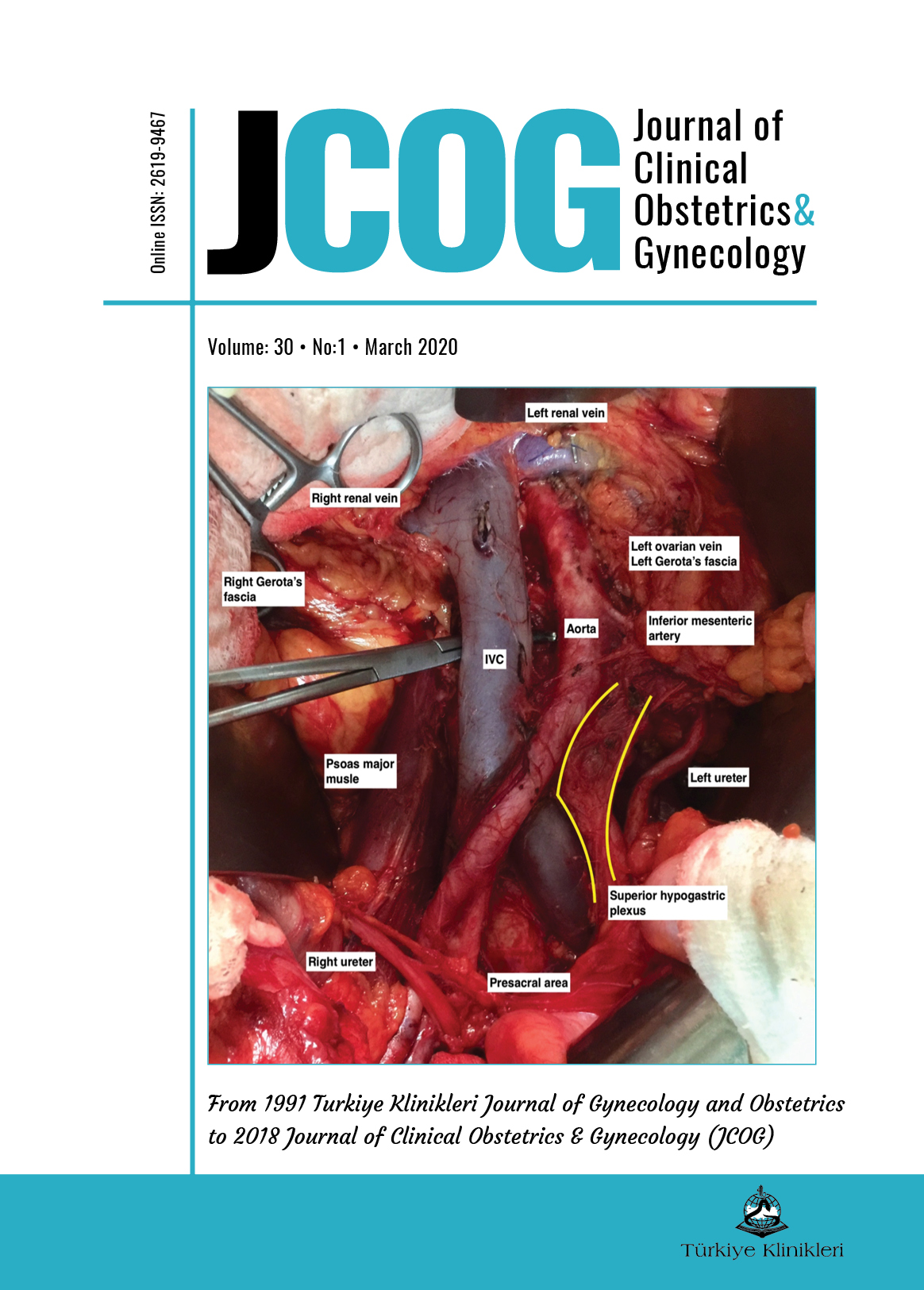Open Access
Peer Reviewed
SCIENTIFIC EVENTS
3855 Viewed1942 Downloaded
Guideline on Pregnancy and Diabetes by the Society of Specialists in Perinatology (PUDER), Turkey
Received: 17 Feb 2020 | Accepted: 18 Feb 2020 | Available online: 20 Feb 2020
J Clin Obstet Gynecol. 2020;30(1):35-42
DOI: 10.5336/jcog.2020-74356
Article Language: EN
Article Language: EN
Copyright Ⓒ 2025 by Türkiye Klinikleri. This is an open access article under the CC BY-NC-ND license (http://creativecommons.org/licenses/by-nc-nd/4.0/)
ABSTRACT
Diabetes mellitus (DM) is the most common endocrinologic problem in pregnancy. In Turkey, the reported prevalance is between 1.9-27.9%, with an average of 7.7%. While some of these cases are pregestational diabetes (PGDM), about 90% are detected during the pregnancy for the first time and diagnosed as gestational diabetes (GDM). Diabetes in pregnancy confers serious risks regarding the fetus, newborn and the mother. Therefore, we offer GDM screening for all pregnant women preferantially between 24-28 weeks of gestation. Either one-step 75-g oral glucose tolerance test (OGTT) or two-step 50-g glucose challenge test and 100-g OGTT may be used for the screening and diagnosis. In pregnancies with high-risk for DM, screening should be performed earlier, if possible, in the first antenatal visit. When GDM is diagnosed, maternal glycemic control is tried to be achieved by diet and exercise program, and if necessary, by using insulin. The use of metformin or glyburide in pregnancy is also possible. In women with the diagnosis of DM before pregnancy, preconceptional control of plasma glucose levels is of utmost importance in order to prevent adverse pregnancy outcomes. In pregnancies with GDM regulated by diet and exercise, pregnancy follow-up may be performed as in the low risk group without any pregnancy complications. If maternal or fetal distress is not observed, delivery is planned between 39+0 -40+6 weeks. Although caesarean section is recommended when estimated fetal weight is 4500 g or more, the mode of delivery may be decided more appropriately on a case-by-case basis.
Diabetes mellitus (DM) is the most common endocrinologic problem in pregnancy. In Turkey, the reported prevalance is between 1.9-27.9%, with an average of 7.7%. While some of these cases are pregestational diabetes (PGDM), about 90% are detected during the pregnancy for the first time and diagnosed as gestational diabetes (GDM). Diabetes in pregnancy confers serious risks regarding the fetus, newborn and the mother. Therefore, we offer GDM screening for all pregnant women preferantially between 24-28 weeks of gestation. Either one-step 75-g oral glucose tolerance test (OGTT) or two-step 50-g glucose challenge test and 100-g OGTT may be used for the screening and diagnosis. In pregnancies with high-risk for DM, screening should be performed earlier, if possible, in the first antenatal visit. When GDM is diagnosed, maternal glycemic control is tried to be achieved by diet and exercise program, and if necessary, by using insulin. The use of metformin or glyburide in pregnancy is also possible. In women with the diagnosis of DM before pregnancy, preconceptional control of plasma glucose levels is of utmost importance in order to prevent adverse pregnancy outcomes. In pregnancies with GDM regulated by diet and exercise, pregnancy follow-up may be performed as in the low risk group without any pregnancy complications. If maternal or fetal distress is not observed, delivery is planned between 39+0 -40+6 weeks. Although caesarean section is recommended when estimated fetal weight is 4500 g or more, the mode of delivery may be decided more appropriately on a case-by-case basis.
REFERENCES:
- Hyer SL, Shehata HA. Gestational diabetes mellitus. Curr Obstet Gynaecol. 2005;15:368-74. [Crossref]
- Menato G, Bo S, Signorile A, Gallo ML, Cotrino I, Poala CB, et al. Current management of gestational diabetes mellitus. Expert Rev Obstet Gynecol. 2008;3:73-91. [Crossref]
- Diabetes in Pregnancy: Management from preconception to the postnatal period. NICE Guideline; 2015.
- Karaçam Z, Çelik D. The prevalence and risk factors of gestational diabetes mellitus in Turkey: a systematic review and meta-analysis. J Matern Fetal Neonatal Med. 2019;2:1-11. [Crossref] [PubMed]
- Karçaaltıncaba D, Calis P, Ocal N, Ozek A, Altuğ Inan M, Bayram M. Prevalence of gestational diabetes mellitus evaluated by universal screening with a 75-g, 2-hour oral glucose tolerance test and IADPSG criteria. Int J Gynaecol Obstet. 2017;138(2):148-51. [Crossref] [PubMed]
- Çabuk E, Duru SA, Akal C, Olten B, Eroğlu D, Yanık FF. Maternal characteristics and perinatal outcomes in pregnancies with abnormal 50 g oral glucose challenge test and normal 100 g oral glucose test results. Poster Presentation. Bucharest, Romania: The 4th Congress of the South-East European Society of Perinatal Medicine; 2011.
- ACOG Practice Bulletin No. 201: Pregestational Diabetes Mellitus. Obstet Gynecol. 2018;132(6):e228-48. [Crossref] [PubMed]
- Cunningham FG, Leveno KJ, Bloom SL, et al. Diabetes mellitus. In: Leveno KJ, Spong CY, Dashe JS, Casey BM, Hoffman BL, Cunningham FG, et al, eds. Williams Obstetrics. 25th ed. USA: McGraw Hill; 2018. p.1097-117.
- Management of diabetes in pregnancy: Standards of medical care in diabetes-2019, American Diabetes Association. Diabetes Care. 2019;42 (Suppl 1):S165-72. [Crossref] [PubMed]
- HAPO Study Cooperative Research Group. Hyperglycemia and adverse pregnancy outcomes. N Engl J Med. 2008;358:1991-2002. [Crossref] [PubMed]
- Garner PR. Type I diabetes and pregnancy. Lancet. 1995;346(8968):157-61. [Crossref]
- ACOG Committee Opinion. No 700 Methods for Estimating the Due Date. Obstet Gynecol. 2017;129(5):e150-4. [Crossref] [PubMed]
- T.C. Sağlık Bakanlığı Türkiye Halk Sağlığı Kurumu. Riskli Gebelikler Yönetim Rehberi. Sağlık Bakanlığı Yayın No: 926. Ankara: Sağlık Bakanlığı; 2014. p.65.
- Classification and diagnosis of diabetes: standards of medical care in diabetes-2019, American Diabetes Association. Diabetes Care. 2019;42(Suppl 1):S13-28. [Crossref] [PubMed]
MENU
POPULAR ARTICLES
MOST DOWNLOADED ARTICLES





This journal is licensed under a Creative Commons Attribution-NonCommercial-NoDerivatives 4.0 International License.










